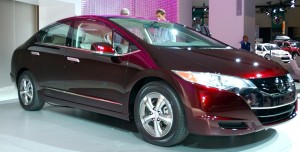
Dear EarthTalk: Is it true that fuel cell cars aren’t really any greener than conventional gas-powered internal combustion cars? — Michelle Adamo, Portland, OR
A decade ago cars powered by fuel cells seemed like the future of green automotive travel, but many analysts now think otherwise.
These futuristic cars run on hydrogen fuel and emit only heat and water vapor. Their engines mix hydrogen, stored on-board in fuel tanks much like gas tanks, with oxygen in the air to produce electricity that powers the drive train. Environmentalists love the idea of fuel cell cars given their lack of greenhouse gas emissions and reliance on a renewable fuel that can be produced domestically.
Despite these benefits, fuel cell cars have not caught on and skeptics wonder if they ever will. One big hurdle is that creating hydrogen fuel turns out to be highly inefficient compared to other readily available fuels. According to Richard Gilbert, co-author of Transport Revolutions: Moving People and Freight Without Oil, the creation of hydrogen gas uses about half the energy it creates. Half of this resulting energy then goes to the conversion of hydrogen back into electricity within fuel cells. The result is that “only a quarter of the initially available energy reaches the electric motor.” In fact, hydrogen fuel cell vehicles’ efficiency varies between 18 and 20 percent, while battery electric vehicles have 77-80 percent efficiency.
Not only are fuel cells less efficient than internal combustion engines, their implementation on a wide scale would create enormous infrastructure costs. New infrastructure would be required from “wells to wheels.” Also, fuel cell motors wear out five times faster than internal combustion engines, thereby resulting in a shorter car life and more maintenance. Hydrogen’s small size and extreme reactivity results in brittle metal and engines prone to leaking, which reduces both environmental and practical benefits.
But many still consider fuel cell cars a viable option. “Hydrogen is the key to sustainable transportation because it can be produced in virtually unlimited quantities from renewable resources and because its use is nearly pollution-free,” says the non-profit INFORM. A significant financial commitment to hydrogen research, says the group, could result in a variety of vehicles fueled by hydrogen that perform as well or better than gasoline vehicles, with a fraction of the environmental impact.
INFORM adds that transitioning to hydrogen could be achieved without new federal dollars if we reallocate funds within the national energy program from nuclear and fossil fuels. “The opportunities for innovation and economic growth in hydrogen energy are largely untapped, and many nations are working to establish an early position in this fledgling field.” According to INFORM, Germany and Japan are far ahead of the U.S. in hydrogen development. The group would like to see U.S. policymakers encourage more development of fuel cells so we have options open in a fast-transitioning energy future.
Meanwhile, sales of battery electric and hybrid vehicles continue to soar—rising 228 percent in 2013 alone. There are currently no new fuel cell vehicles for sale at American auto dealers, although Honda has hinted that it could have its FCX fuel cell engine ready for the mass market by 2018.
CONTACTS: INFORM, www.informinc.org/; Honda FCX, http://automobiles.honda.com/fcx-clarity/.
EarthTalk® is written and edited by Roddy Scheer and Doug Moss and is a registered trademark of E – The Environmental Magazine (www.emagazine.com). Send questions to: earthtalk@emagazine.comearthtalk@emagazine.com.





Well said EarthTalk. H2 is not a viable “fuel”. It is far less efficient than plugging in. We already have a vast electricity infrastructure that plug-in cars can use. H2 is mostly (98%) generated from natural gas reforming. That means that it is derived from fossil fuels, not renewable energy. Putting solar on your home and charging an EV is a much better choice if you want to be green.
One important reason they haven’t caught on is that there are an
insufficient amount of stations for fueling thereby limiting the distance a car may travel and in turn, the consumers will not buy.
If they use hydrogen in a submarine, they can use it in a car.